Lithuania E-commerce Market Size
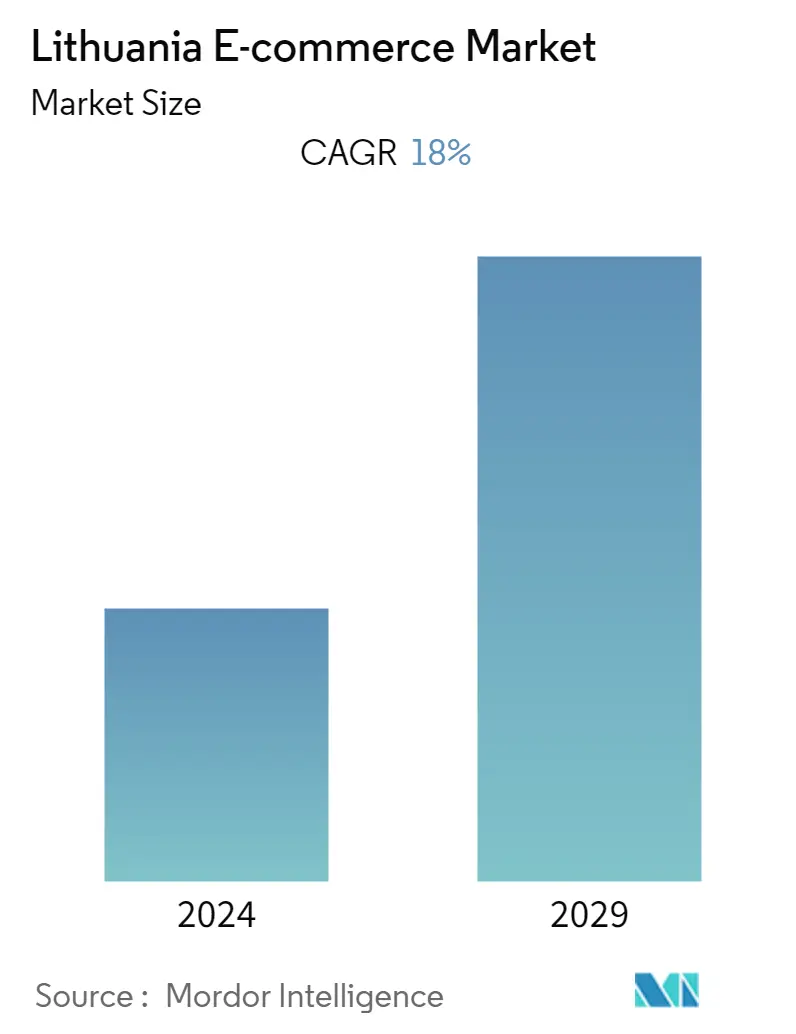
| Study Period | 2019 - 2029 |
| Base Year For Estimation | 2023 |
| Forecast Data Period | 2024 - 2029 |
| Historical Data Period | 2019 - 2022 |
| CAGR | 18.00 % |
| Market Concentration | Medium |
Major Players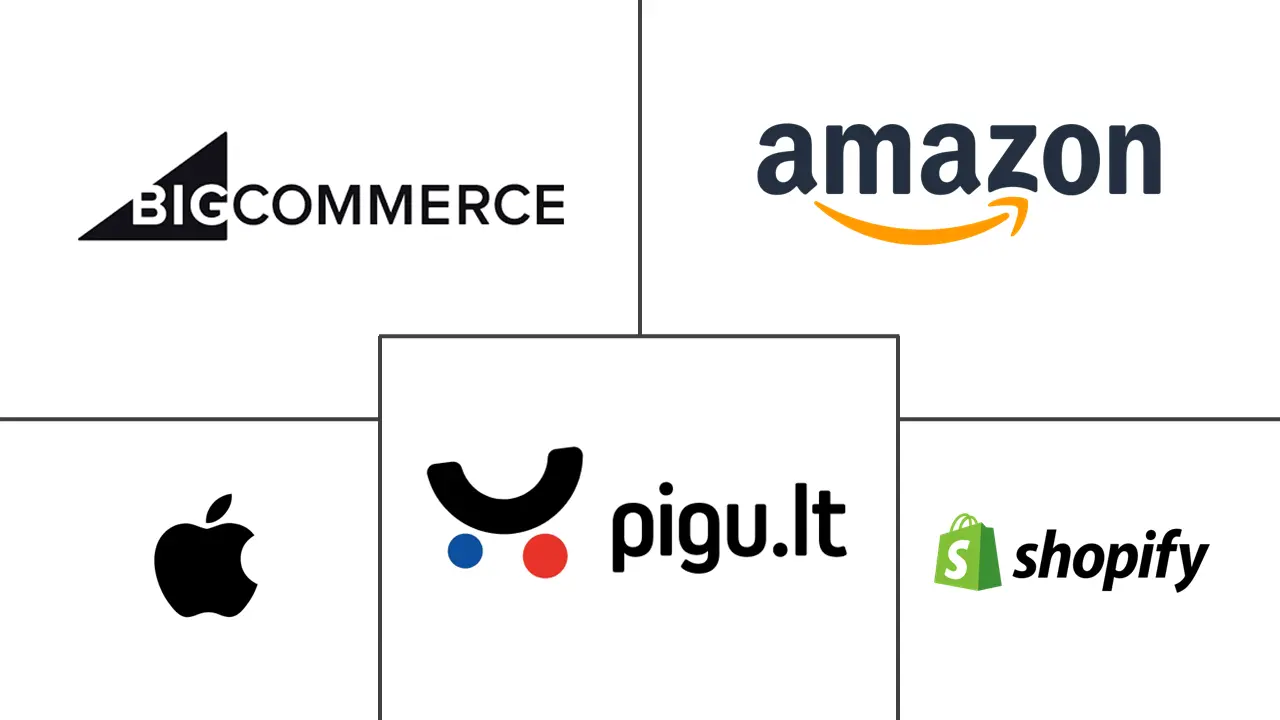
*Disclaimer: Major Players sorted in no particular order |
Lithuania E-commerce Market Analysis
The Lithuania e-commerce market is anticipated to register a CAGR of 18% during the forecast period (2022- 2027). Despite the variations in the sales processes between B2B and B2C businesses, B2B customers can still have the same user experience as B2C customers, including online storefronts, interactions with chatbots instead of salespeople, online payment portals, and more. B2B clients benefit from the same convenience of online purchasing as B2C customers but with built-in capabilities that account for contract pricing, account hierarchies, and other distinctly B2B characteristics.
- In Lithuania, where e-commerce is prevalent, most online shoppers have made at least one purchase from an online business in their nation. However, a significant number of Lithuanians have purchased items from foreign websites. Due to Lithuania's small size, the populace occasionally lacks a range of items. Because purchasing power is reduced, Lithuanians are increasingly adopting electronic technologies, and virtual transactions are no longer a source of anxiety; successful purchases motivate people to do so even more. However, only a small percentage of these purchasers are long-term.
- Small businesses benefit from going online since they can readily compete with larger companies. When it comes to internet purchasing, it saves money because firms don't have to rent a storefront, and warehousing isn't usually required. It is considerably easier to reach overseas markets by trading online; there is no need to confine oneself to Lithuania. It's worth noting that online trading has a flip side. The major disadvantage of the online store is that users can't view the thing before they buy it. People who are making money are shopping online.
- According to Internation Trade Administration, Lithuania ranks one in the World Competitiveness Rankings for communication technology, and it is one of the EU's leading countries in information and communication technologies. It shows the EU's number of people aged 16 to 24 who have received formal ICT training. Lithuanians have the EU's quickest download and upload speeds. Lithuania leads the continent in terms of the density of public internet connection points. As a result, e-banking is used to complete 92% of all financial transactions. The most advanced ICT technologies (EDGE technology, mobile WiMAX 4G Internet, 3G mobile communications infrastructure, and so on) have been fully implemented and are being used across the country.
- The three-month quarantine in Lithuania prompted businesses to refocus and pay close attention to e-commerce, but it also influenced consumer behavior. According to a study of Lithuanians by Enterprise Lithuania, a non-profit agency under the Ministry of Economy and Innovation of Lithuania, every fifth person bought more than usual online during the quarantine, and roughly a fifth of those polled plan to continue buying more online. During this time, e-commerce in the Baltic States expanded by 80%, and consignment movements in Lithuania increased by 54%. The Entrepreneurship and Export Development Agency conducted a poll on the Lithuanian population.
- In December 2021, Lithuania collaborated with PChome, one of Taiwan's largest e-commerce platforms, to gain a foothold in the East Asian market. The Head of the Export Department at Enterprise Lithuania has stated that this collaboration is expected to support the E-commerce market in the country. The Baltic nation's enterprises are connected to PChome, while related negotiations and logistical concerns are being resolved and anticipated to be completed in the spring.
- In April 2022, Ministers of the Economy and Innovation, as well as the Minister of National Defense, have written to ministers from other European Economic Area countries, urging them to join the Lithuanian initiative, which aims to persuade Apple and Google to remove Yandex apps from European e-commerce platforms. These Russian apps for online passenger transportation service booking represent a risk to personal data security.
Lithuania E-commerce Market Trends
This section covers the major market trends shaping the Lithuania E-commerce Market according to our research experts:
5G Services May Drive the Market
- According to GSMA, Lithuania had 3.91 million cellular mobile connections at the start of 2022. In January 2022, the number of mobile connections in Lithuania was 146.0% of the entire population. The high mobile penetration in the country has led to easy access to e-commerce channels for the people of Lithuania.
- The next generation of mobile networking standards, the 5G network, is positioned to provide an improved end-user experience by introducing new services and applications through seamless coverage, high data rates, low latency, and significantly improved performance and effective communications.
- The advancement of cellular network technology has enabled consumers to experience higher data rates and lower latency, resulting in a significant increase in the use of data-intensive services and apps. Consumer demand for video and business, as well as consumer shifts to cloud services, have prompted a huge increase in the volume of data carried by cellular networks.
- Developments in the 5g technology will provide fast internet services which may provide the customers with uninterrupted services during online shopping. For instance, in March 2022, Lithuania's regulator RRT announced that it allows operators to offer 5G services using their existing spectrum holdings. Such advancements are expected to influence the studied market positively.
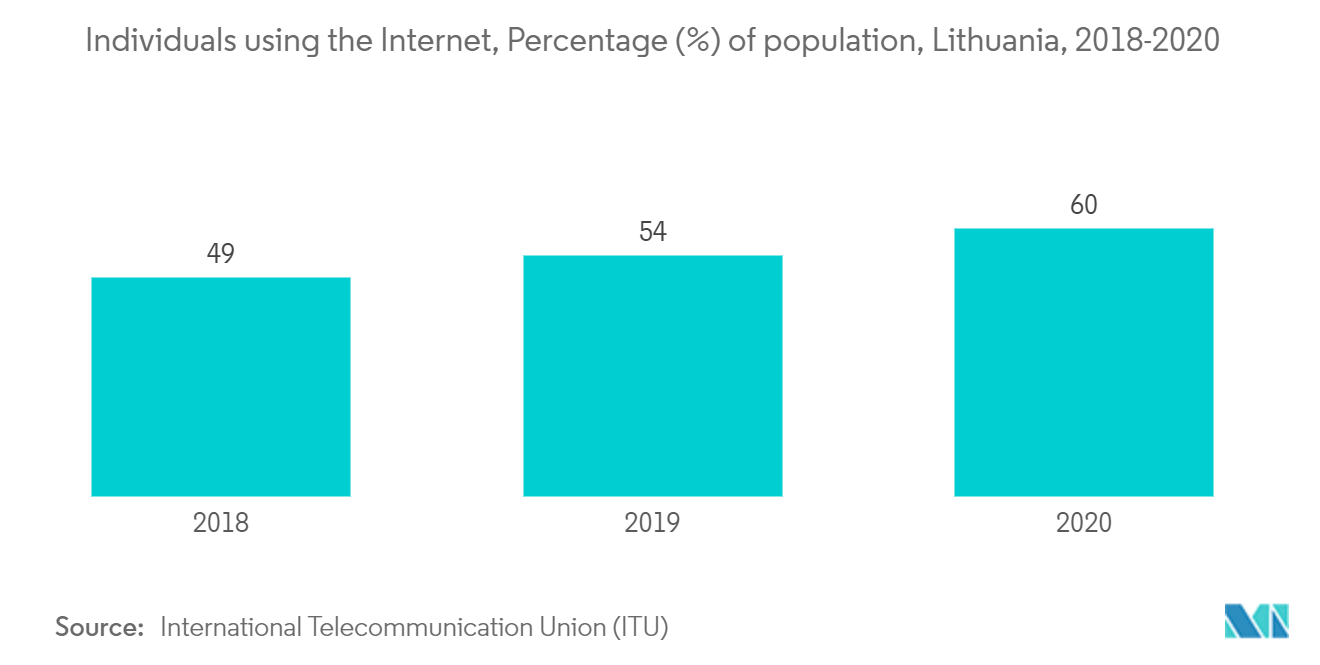
Growth of Food and Beverage industry is One of the Factors Driving the Market
- The increase in the number of coffee and snack outlets is one of the main drivers of the fast food and coffee business growth. Specialty coffees have emerged due to the diversity of tastes and preferences for various varieties of premium coffee, which is driving the development of the market.
- Further, during the COVID-19 pandemic, business closure regulations came into force in March 2020, requiring all snack outlets and cafes not to sell food or drink for consumption on the premises and any part of the premises or part of the premises in which food or beverages are sold for consumption on such premises must be closed. The regulations allowed takeaway and delivery from these snack centers and cafes, which means people can continue to enter the premises to access takeaway services, including delivery drivers. This has led to drastic growth of the market.
- According to United Nations Comtrade, Lithuania's coffee, tea, mate, and spices exports were USD 77.24 million in 2021. Excellent time and information management are critical in the food and beverage industry for a positive customer experience and a smooth purchasing path. The company can provide exactly that with the correct, data-rich, dependable website.
- Customers buy things online using merchant apps/websites and then pick them up in stores. Curbside pickup was already gaining acceptance before COVID-19. Owing to its contactless nature, it acquired even more traction among businesses and consumers with the advent of pandemic-related limitations. In February 2021, Walmart+, for example, had 8 million subscribers.
- If E-commerce is new to the company, it will also necessitate a considerable talent acquisition effort, but bringing in outside talent is frequently the greatest option for success. As a result of adequately organizing around e-commerce, decisions are taken considerably more quickly than they would otherwise. Price changes, for example, can be made numerous times per day online vs. over several months in a physical store.
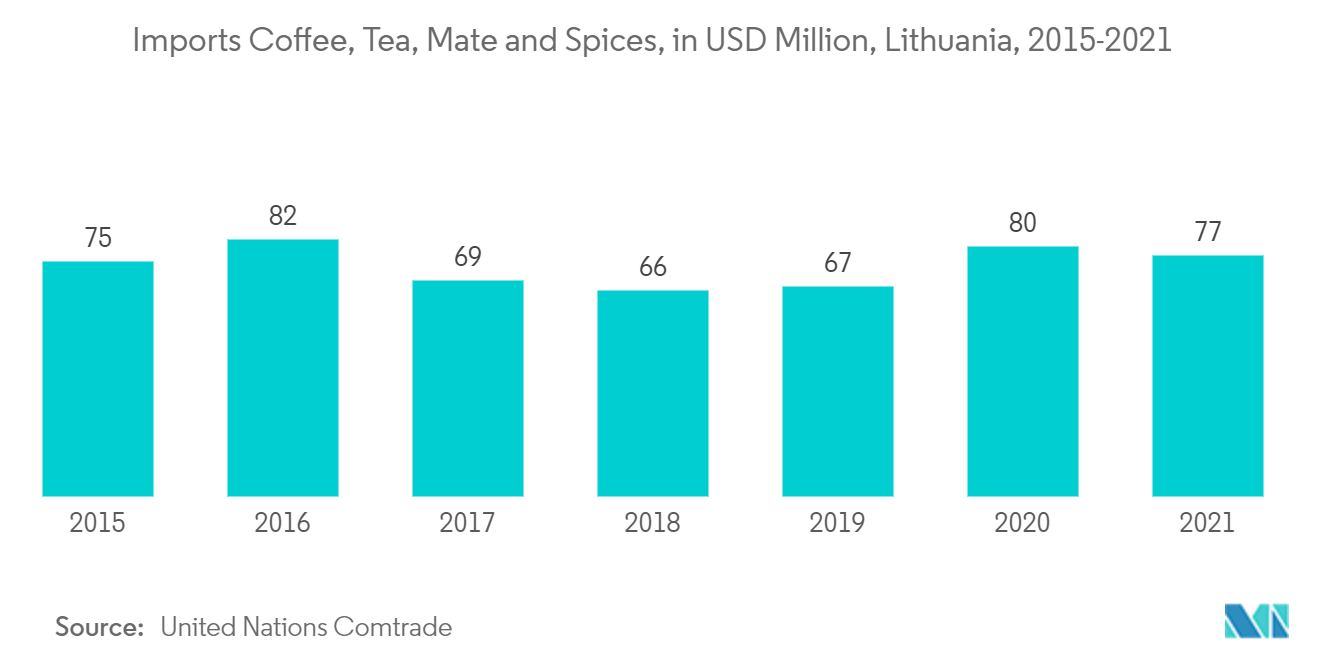
Lithuania E-commerce Industry Overview
In Lithuania, the competition in the E-commerce market has increased as the customer's adoption of online sales channels has grown.The market is moderately low. This growth is aided by an increase in internet penetration.
- February 2022 - Madista Mundus, a Lithuanian startup, has announced the debut of its new venture, the Futugo app, which will alter how people consume fine art and luxury clothes in the web 3.0 revolution. It intends to become the new standard for purchasing high-end goods, digital NFT art, and attending fashion events in the metaverse. The Futugo app will have a physical goods in e-commerce platform, a fully-featured social network, 3D storefronts, live events, digital NFT fashion and art objects, unique discounts, and personal assistants to enable users navigate the complex digital fashion paradise.
- February 2022 - Spanish architecture practice Atelier Entropic has developed a new e-commerce hub featuring a new roof motif in Kaunas, Lithuania. The project spans 70,400 square meters and reimagines the traditional big-box typology of warehouse/retail programming to create a continuous street of programs, complete with plazas, green spaces, and public functions.
Lithuania E-commerce Market Leaders
-
Amazon.com Inc
-
Pigu.lt
-
Apple Inc
-
Shopify
-
BigCommerce
*Disclaimer: Major Players sorted in no particular order
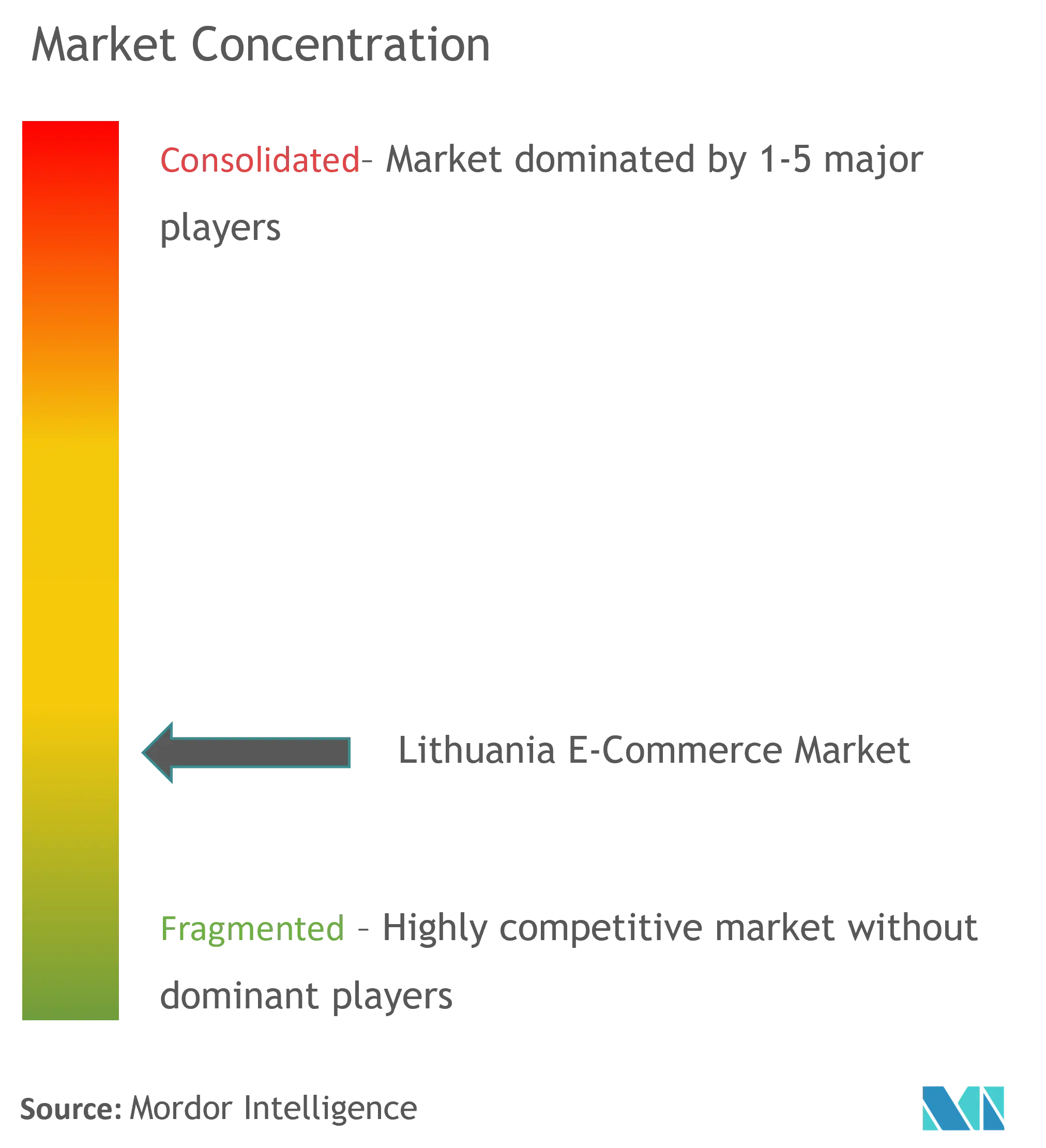
Lithuania E-commerce Market News
- May 2022 - RippleNet's On-Demand Liquidity (ODL), which leverages XRP for crypto-enabled cross border payments, has announced a partnership with FINCI, the Lithuanian online international money transfer provider, to deliver instant and cost-effective retail remittances and business to business (B2B) payments via RippleNet's On-Demand Liquidity (ODL).
Lithuania E-commerce Market Report - Table of Contents
1. INTRODUCTION
- 1.1 Study Assumptions and Market Definitions
- 1.2 Scope of the Study
2. RESEARCH METHODOLOGY
3. EXECUTIVE SUMMARY
4. MARKET INSIGHTS
- 4.1 Market Overview
-
4.2 Industry Attractiveness-Porter's Five Force Analysis
- 4.2.1 Bargaining Power of Suppliers
- 4.2.2 Bargaining Power of Buyers/Consumers
- 4.2.3 Threat of New Entrants
- 4.2.4 Threat of Substitute Products
- 4.2.5 Intensity of Competitive Rivalry
- 4.3 Key Market Trends and Share of E-commerce of Total Retail Sector
- 4.4 Impact of COVID-19 on the E-commerce Sales
5. MARKET DYNAMICS
-
5.1 Market Drivers
- 5.1.1 Increase developments of 5G Technology
- 5.1.2 Increased Adoption of Smartphones
-
5.2 Market Challenges
- 5.2.1 Data Security
- 5.3 Analysis of Key Demographic Trends and Patterns Related to E-commerce Industry in Lithuania (Coverage to include Population, Internet Penetration, ecommerce Penetration, Age & Income etc.)
- 5.4 Analysis of the Key Modes of Transaction in the E-commerce Industry in Lithuania (coverage to include prevalent modes of payment such as cash, card, bank transfer, wallets, etc.)
- 5.5 Analysis of Cross-border E-commerce Industry in Lithuania (Current market value of cross-border & key trends)
- 5.6 Current Positioning of Lithuania in the E-commerce Industry in the Region
6. Market Segmentation
-
6.1 By B2C E-commerce
- 6.1.1 Market size (GMV) for the Period of 2017-2027
- 6.1.2 Market Segmentation - by Application
- 6.1.2.1 Beauty and Personal Care
- 6.1.2.2 Consumer Electronics
- 6.1.2.3 Fashion and Apparel
- 6.1.2.4 Food and Beverage
- 6.1.2.5 Furniture and Home
- 6.1.2.6 Others (Toys, DIY, Media, etc.)
-
6.2 By B2B E-commerce
- 6.2.1 Market size for the Period of 2017-2027
7. Competitive Landscape
-
7.1 Company Profiles
- 7.1.1 Amazon.com Inc
- 7.1.2 Pigu.lt
- 7.1.3 Apple Inc
- 7.1.4 Shopify
- 7.1.5 BigCommerce
- 7.1.6 Senukai.lt
- 7.1.7 Flatlogic
- 7.1.8 Flipkart
- 7.1.9 Parduotuvevaikams.lt
- 7.1.10 Kosmada.lt
- *List Not Exhaustive
8. Investment Analysis
9. Future Outlook of the Market
** Subject To AvailablityLithuania E-commerce Industry Segmentation
Conducting an e-commerce business means fostering relationships and selling information, services, and goods over computer communication networks. E-commerce usually refers to trading goods and services over the internet, which means broader economic activity. E-commerce consists of B2B and B2C and internal organizational transactions that support these activities.
The study also tracks the key market parameters, underlying growth influencers, and major vendors operating in the industry, which supports the market estimations and growth rates over the forecast period in Lithuania. The study further analyzes the overall impact of Covid-19 on the ecosystem. The scope of the report encompasses market sizing and forecast for segmentation by B2B and B2C, in which the B2C channel is further segmented by application.
| By B2C E-commerce | Market size (GMV) for the Period of 2017-2027 | |
| Market Segmentation - by Application | Beauty and Personal Care | |
| Consumer Electronics | ||
| Fashion and Apparel | ||
| Food and Beverage | ||
| Furniture and Home | ||
| Others (Toys, DIY, Media, etc.) | ||
| By B2B E-commerce | Market size for the Period of 2017-2027 |
Lithuania E-commerce Market Research FAQs
What is the current Lithuania E-commerce Market size?
The Lithuania E-commerce Market is projected to register a CAGR of 18% during the forecast period (2024-2029)
Who are the key players in Lithuania E-commerce Market?
Amazon.com Inc, Pigu.lt, Apple Inc, Shopify and BigCommerce are the major companies operating in the Lithuania E-commerce Market.
What years does this Lithuania E-commerce Market cover?
The report covers the Lithuania E-commerce Market historical market size for years: 2019, 2020, 2021, 2022 and 2023. The report also forecasts the Lithuania E-commerce Market size for years: 2024, 2025, 2026, 2027, 2028 and 2029.
Lithuania E-commerce Industry Report
Statistics for the 2024 Lithuania E-commerce market share, size and revenue growth rate, created by Mordor Intelligence™ Industry Reports. Lithuania E-commerce analysis includes a market forecast outlook to 2029 and historical overview. Get a sample of this industry analysis as a free report PDF download.



